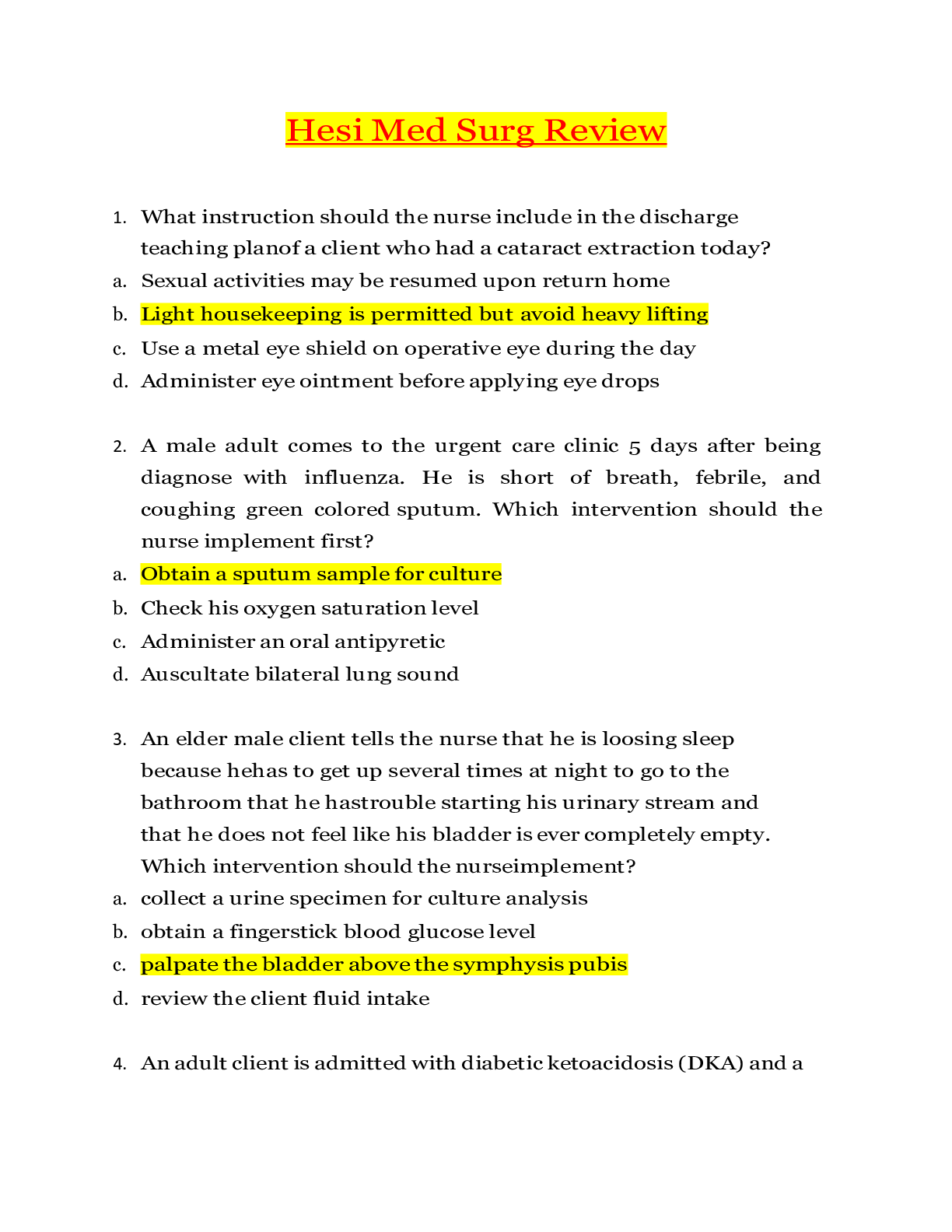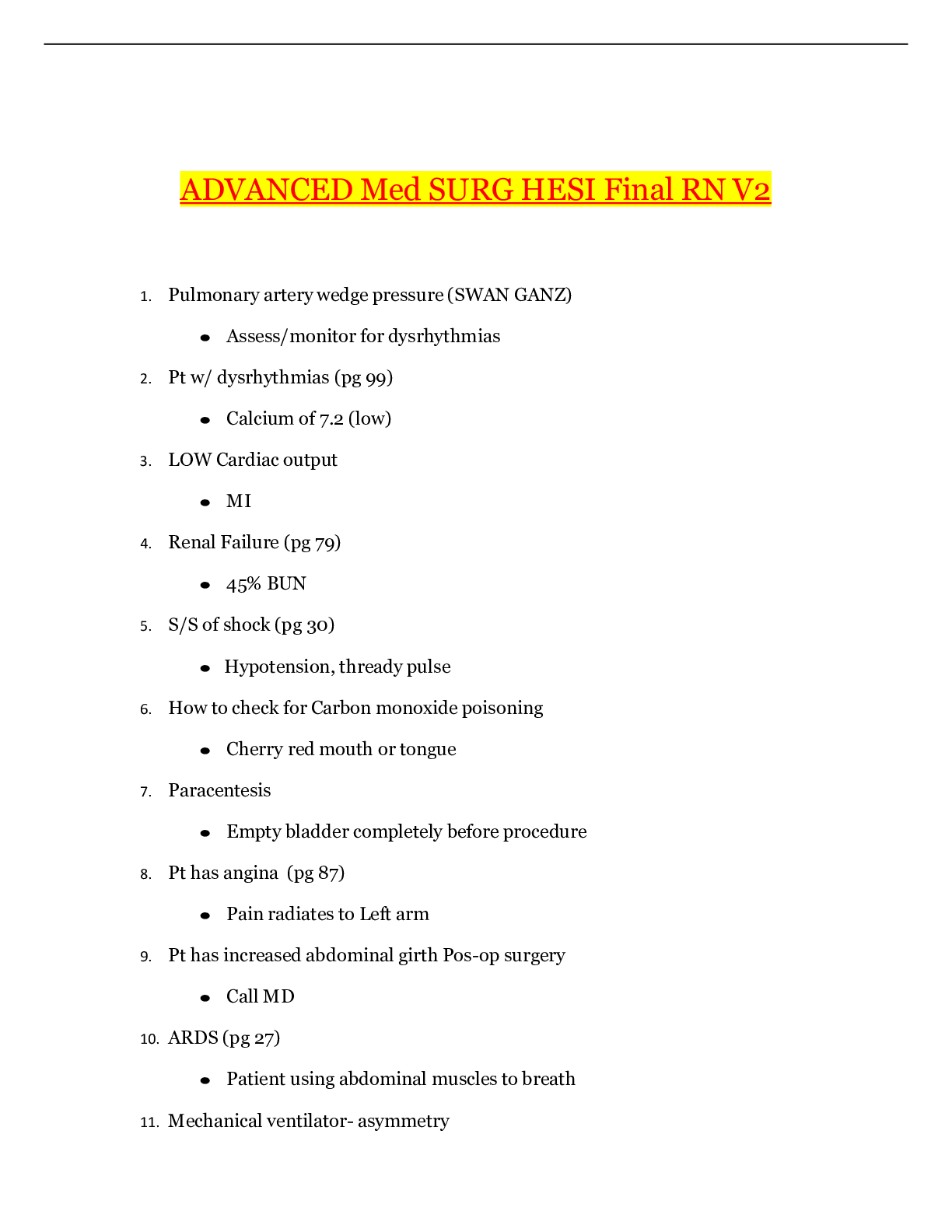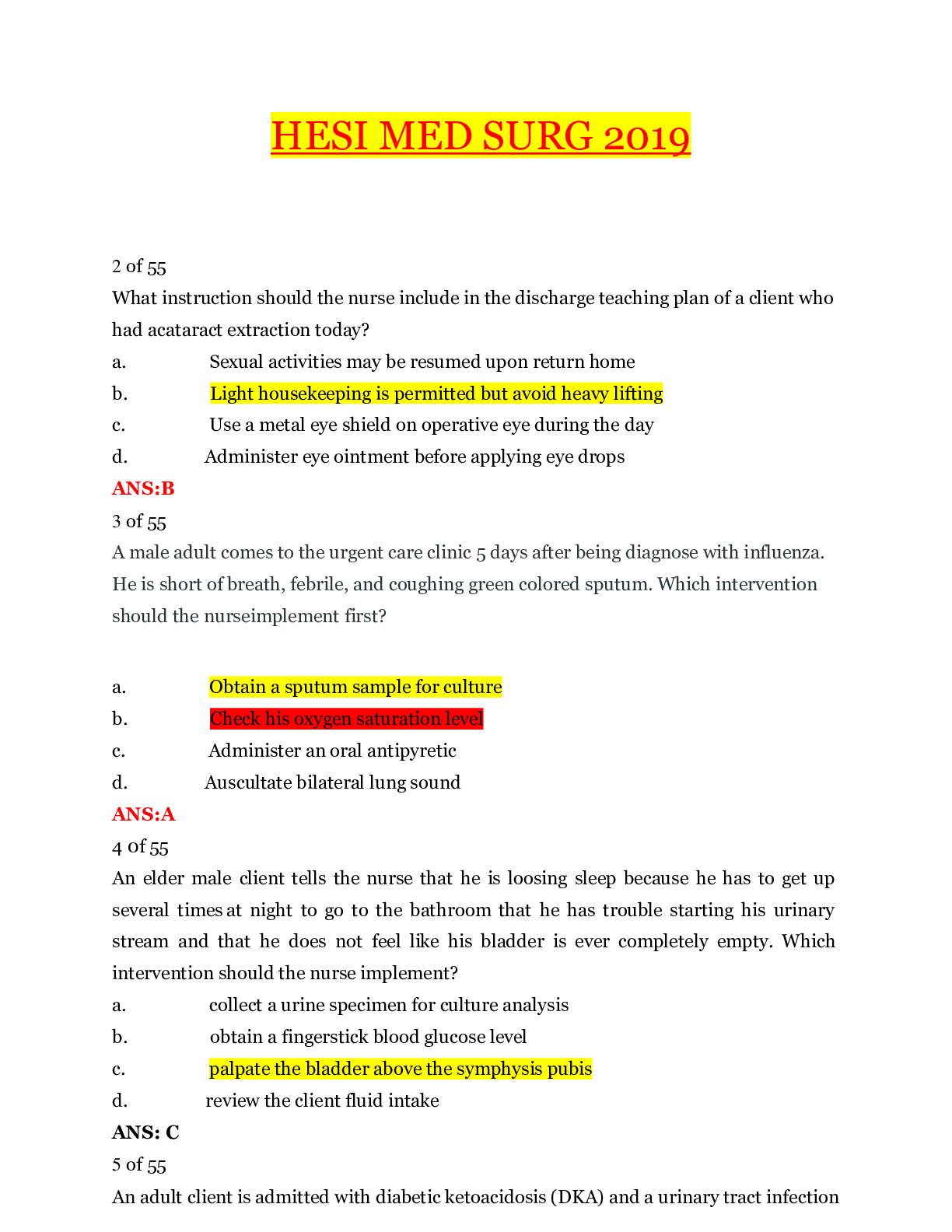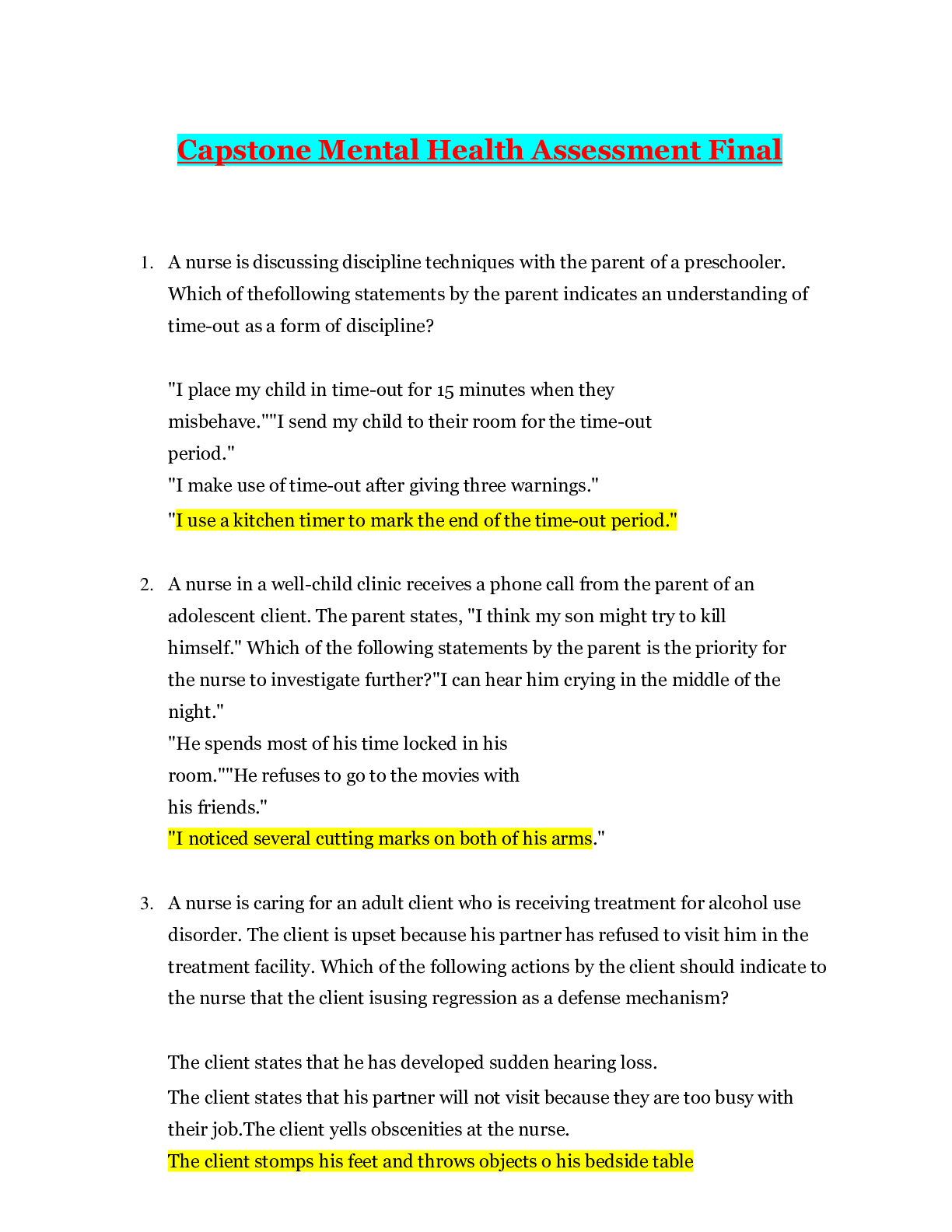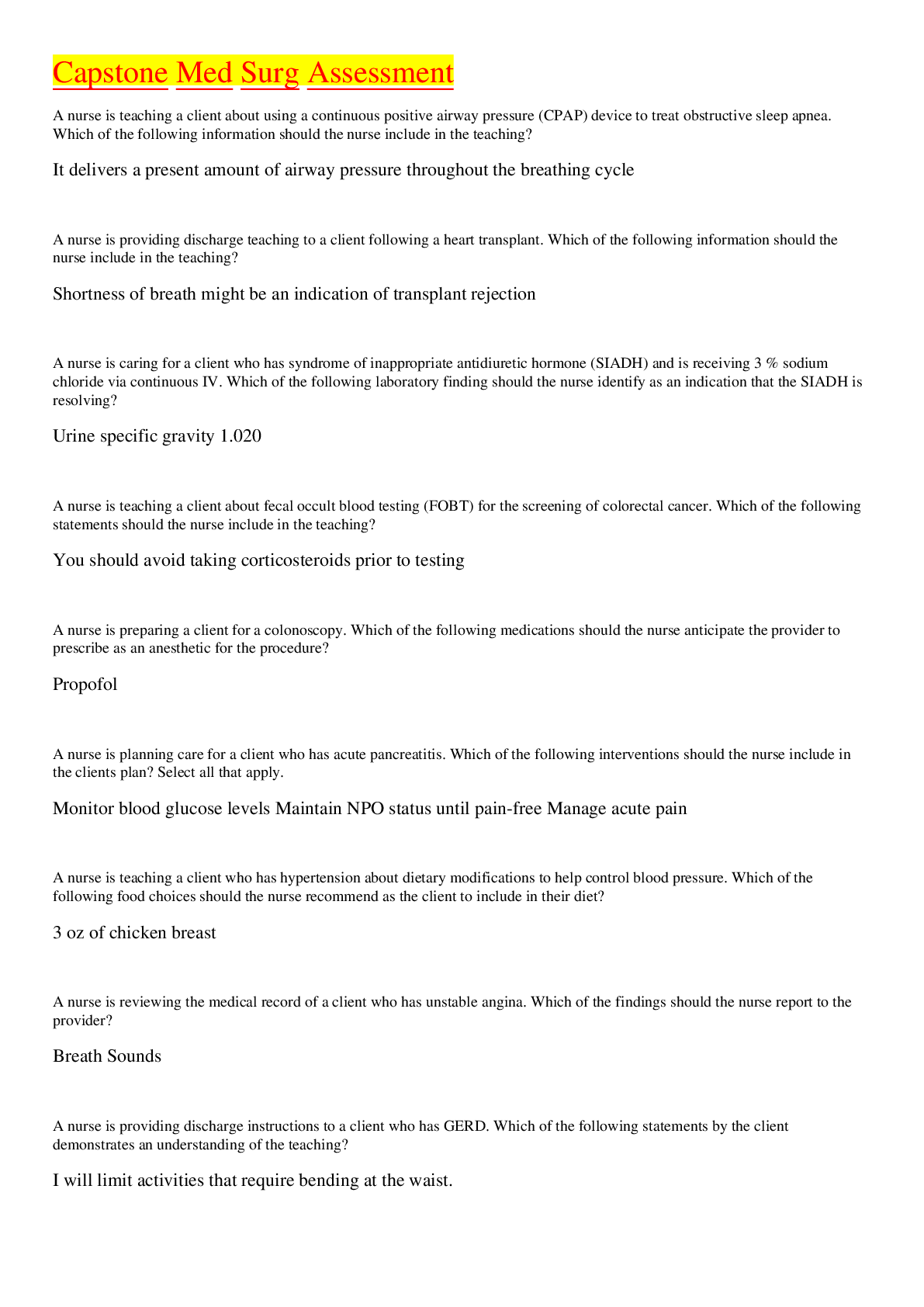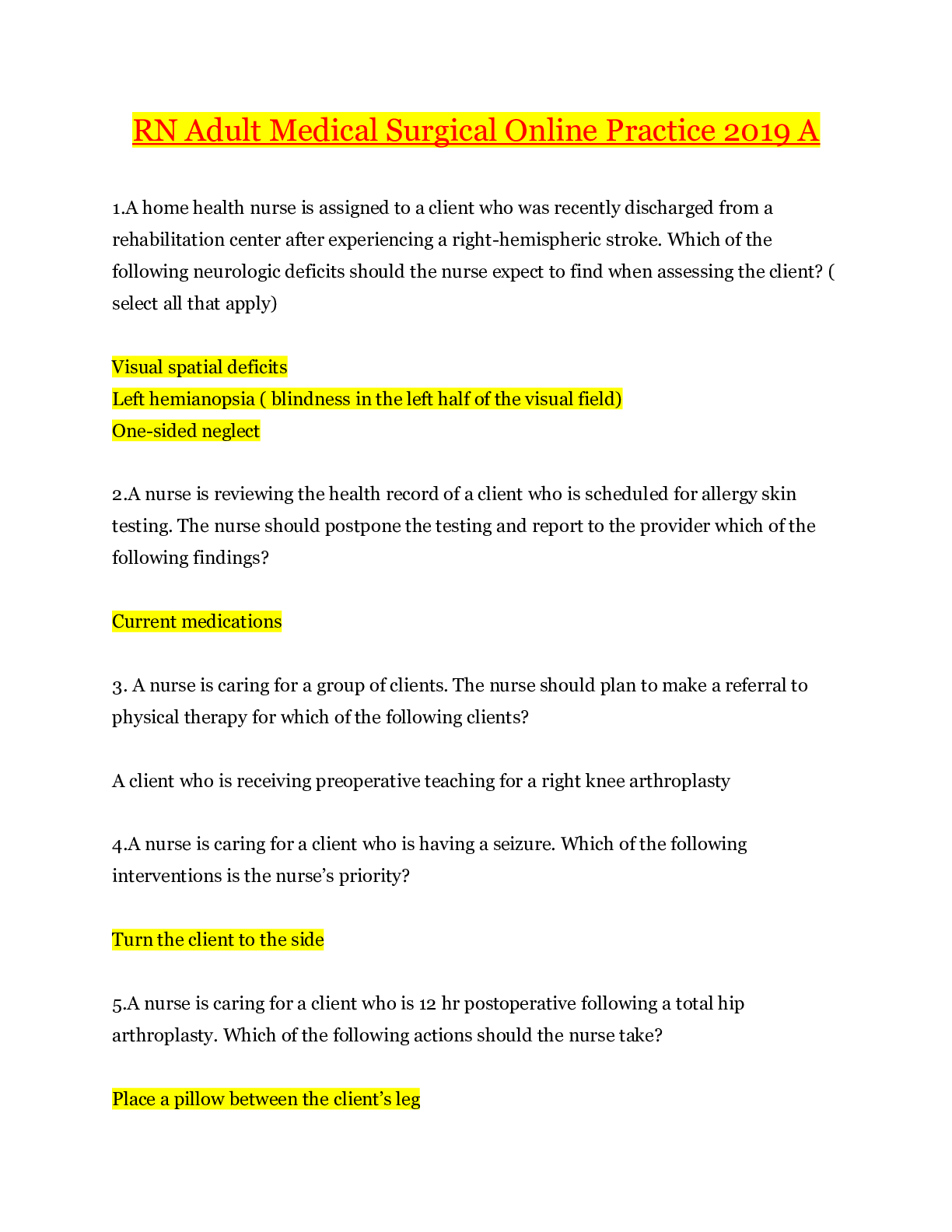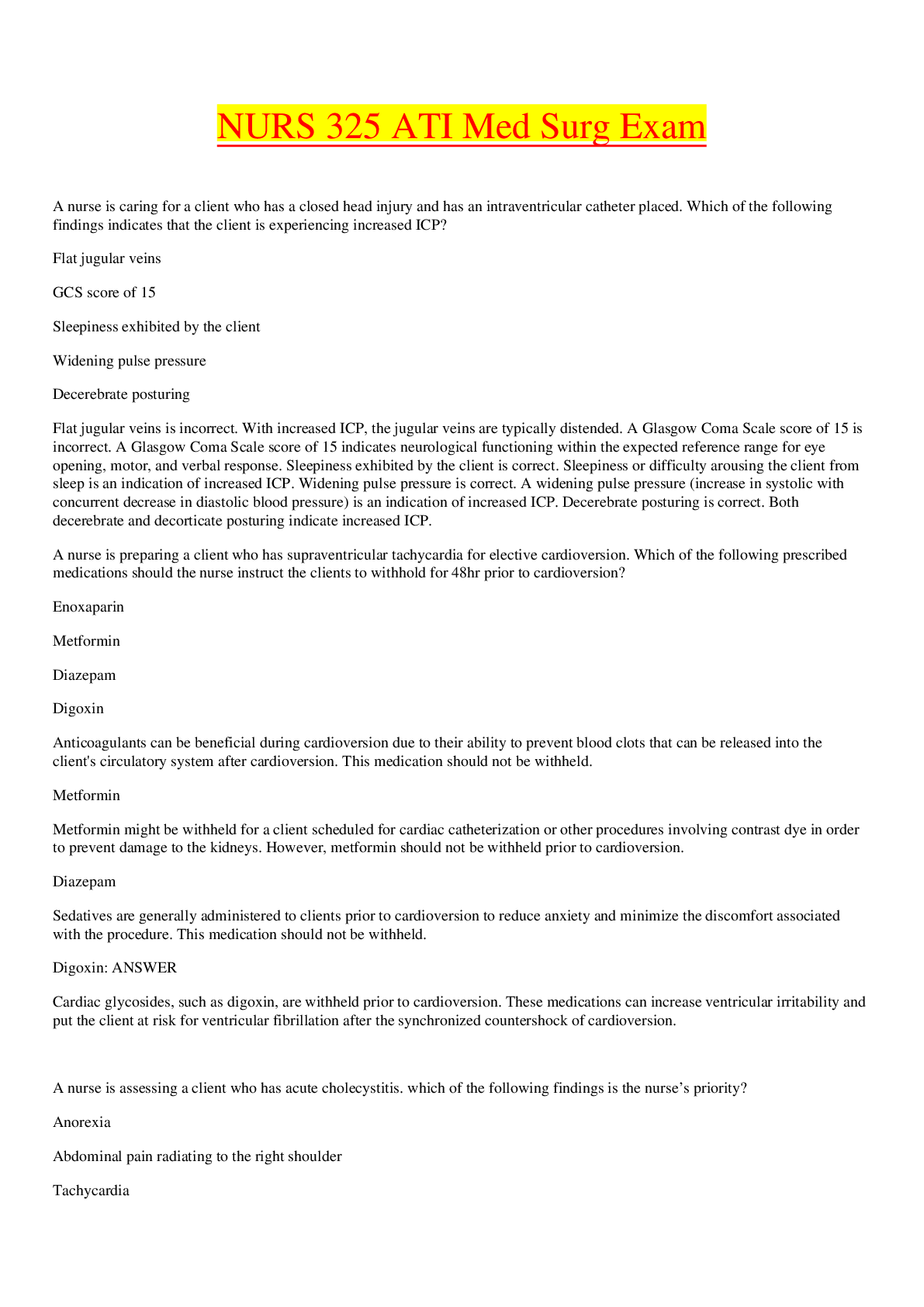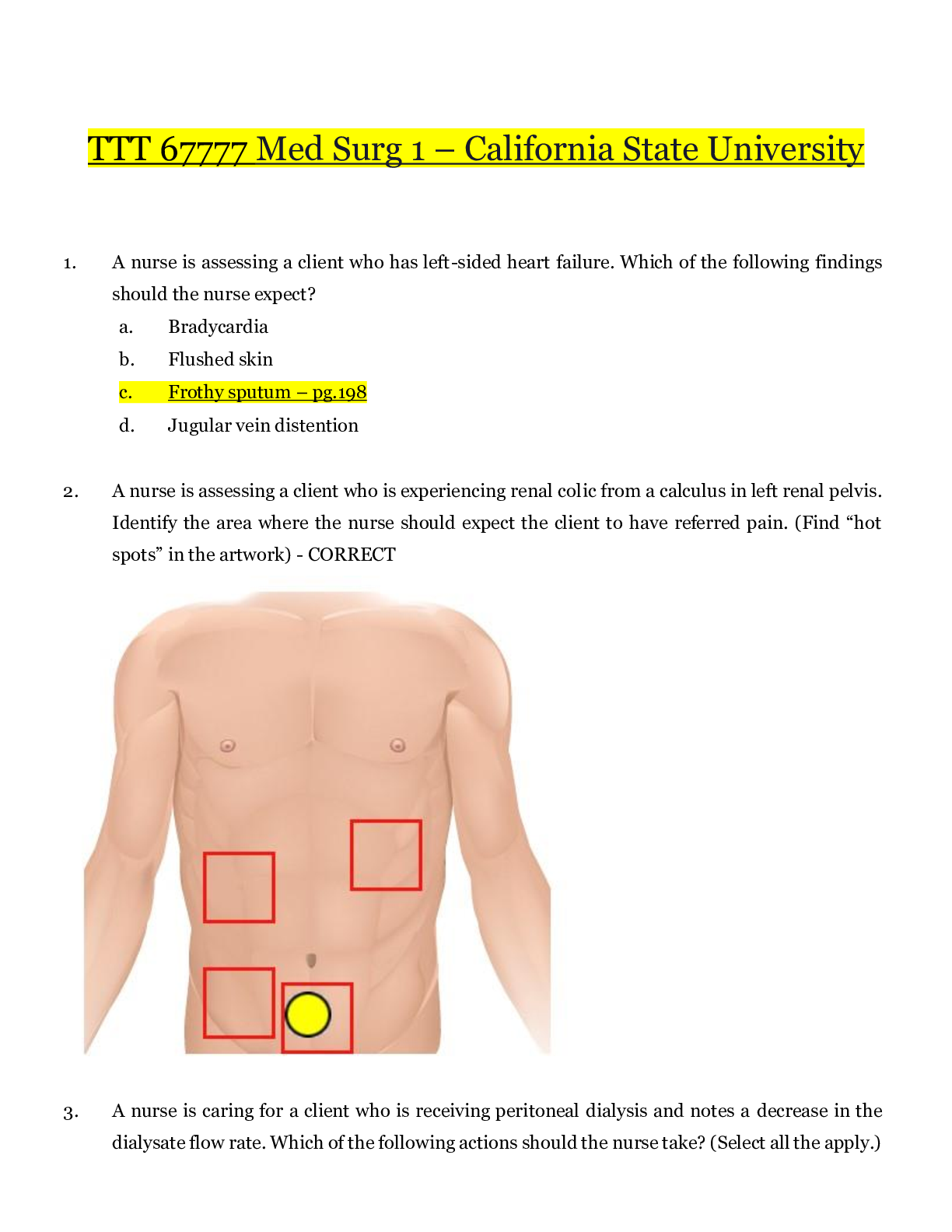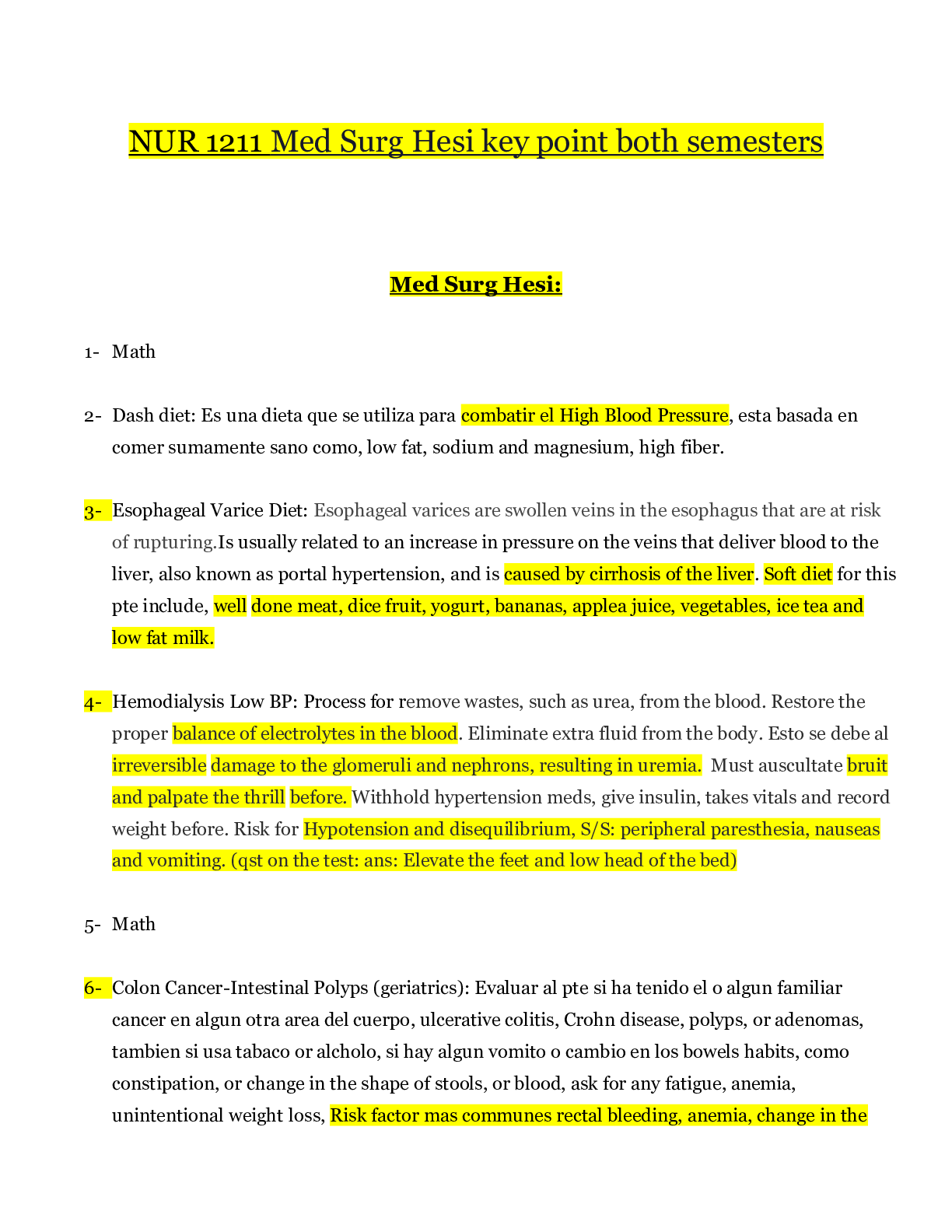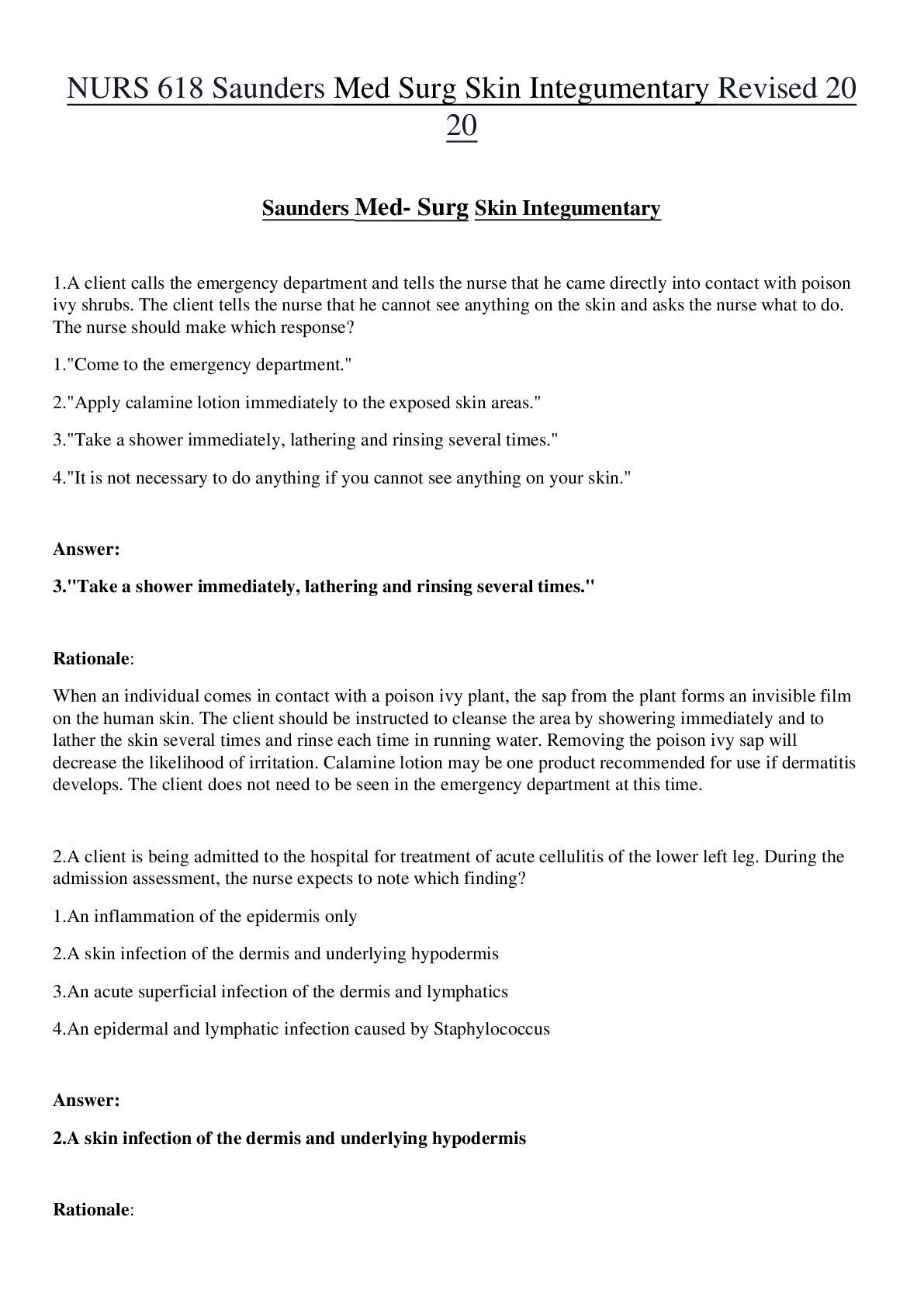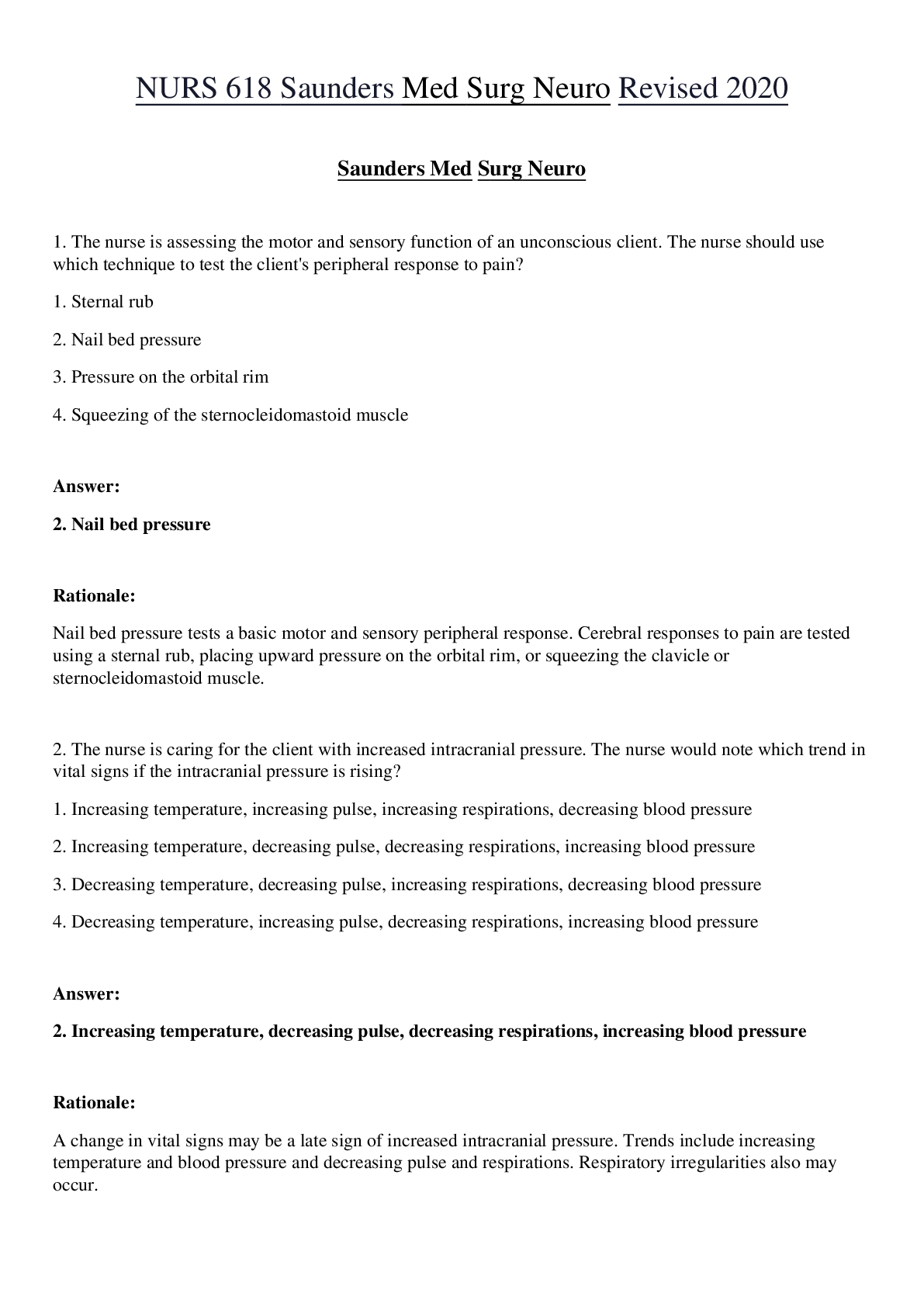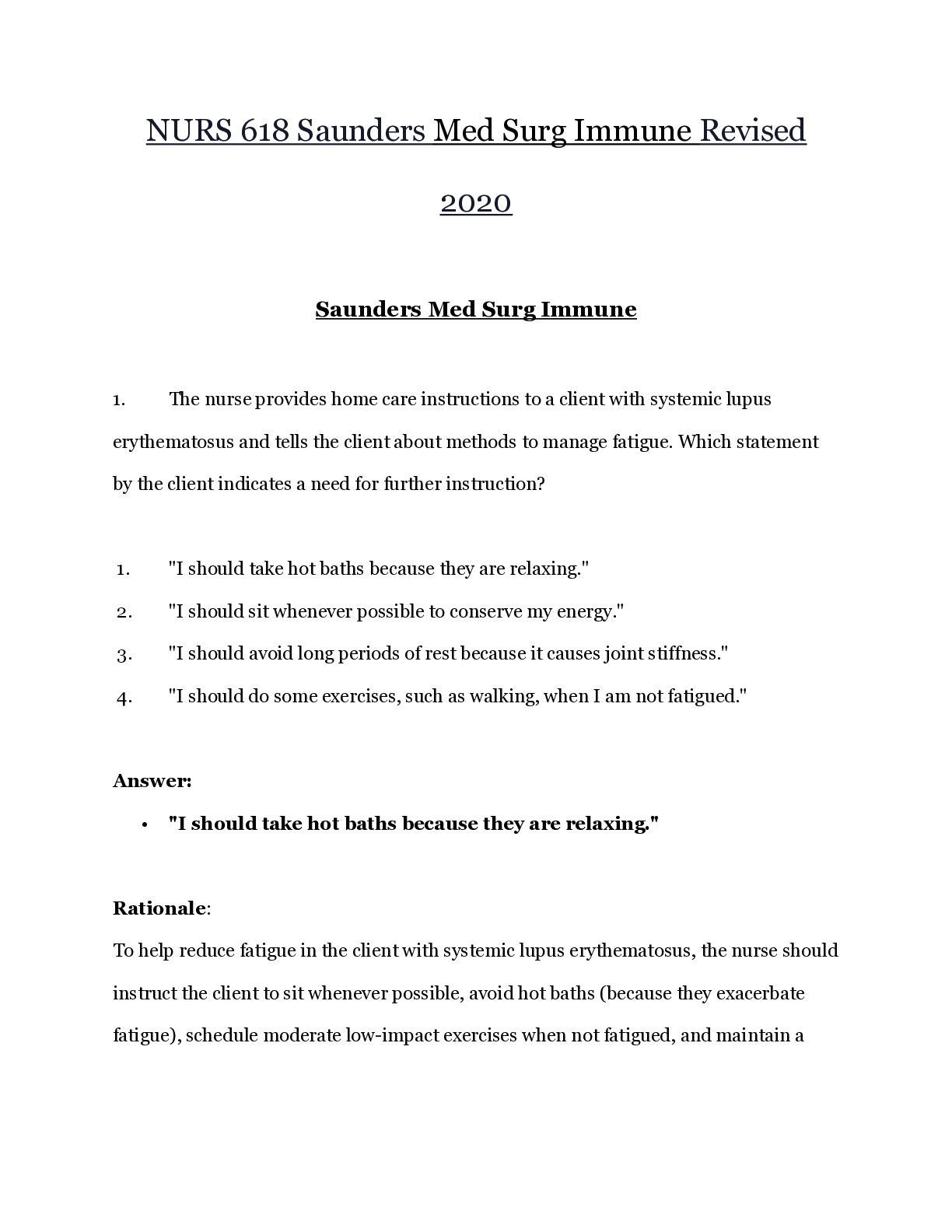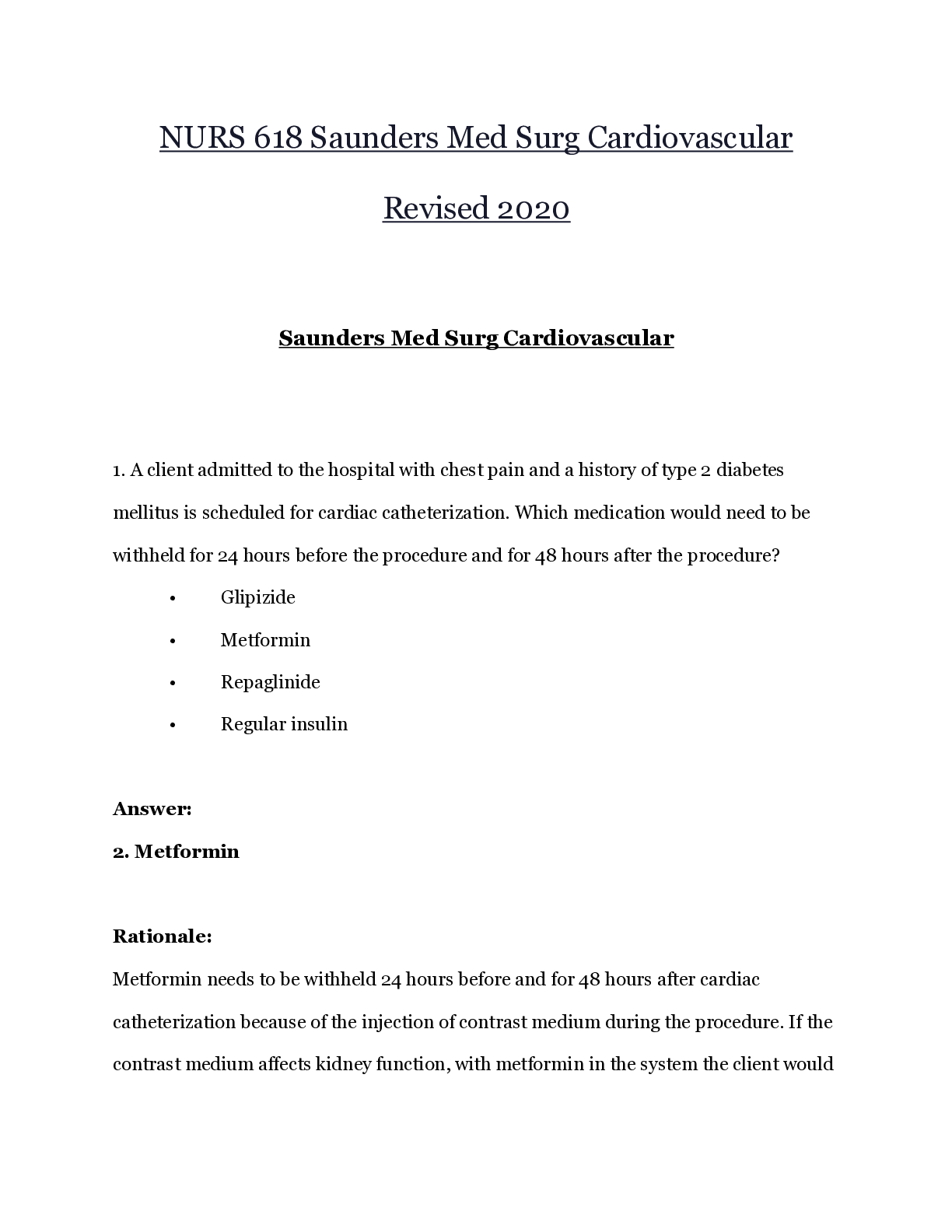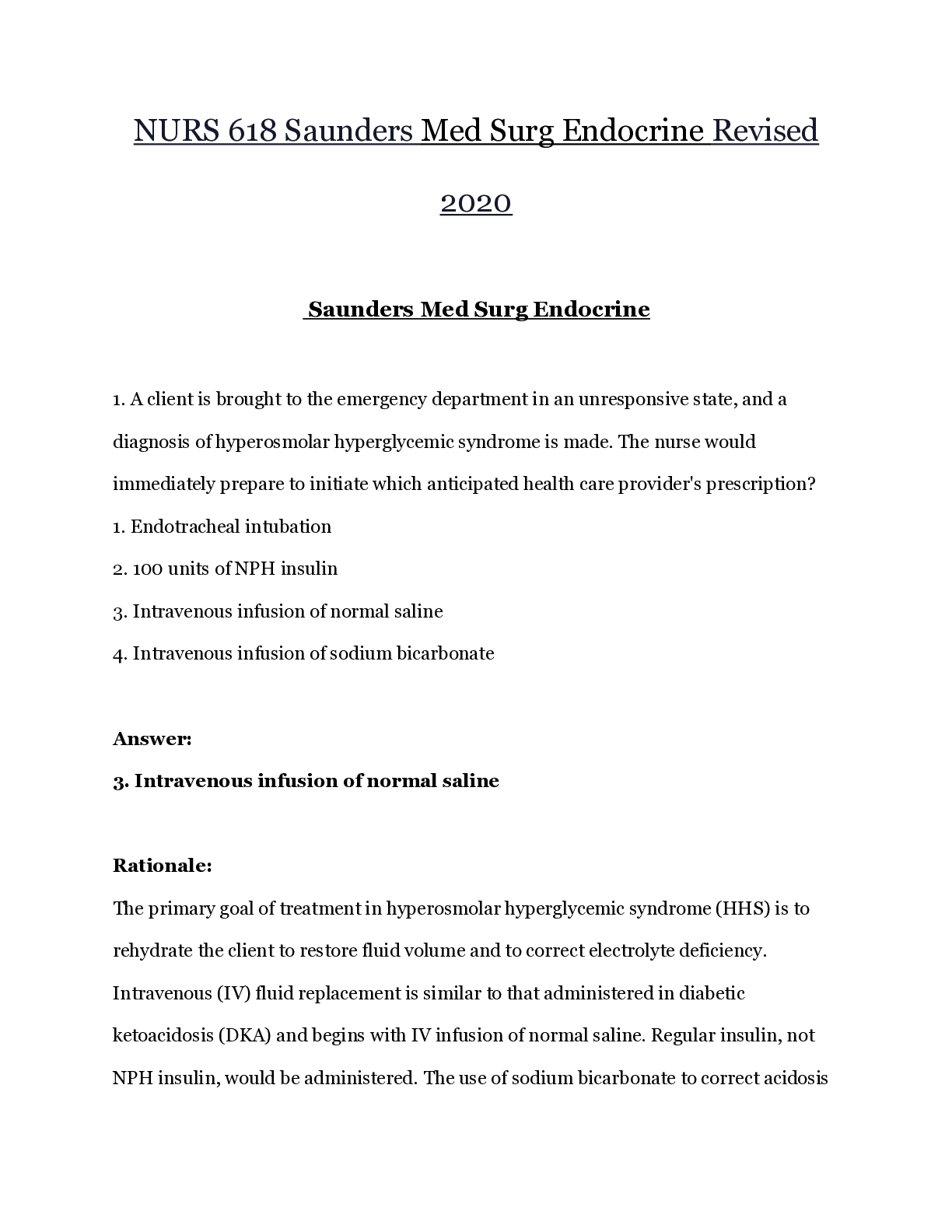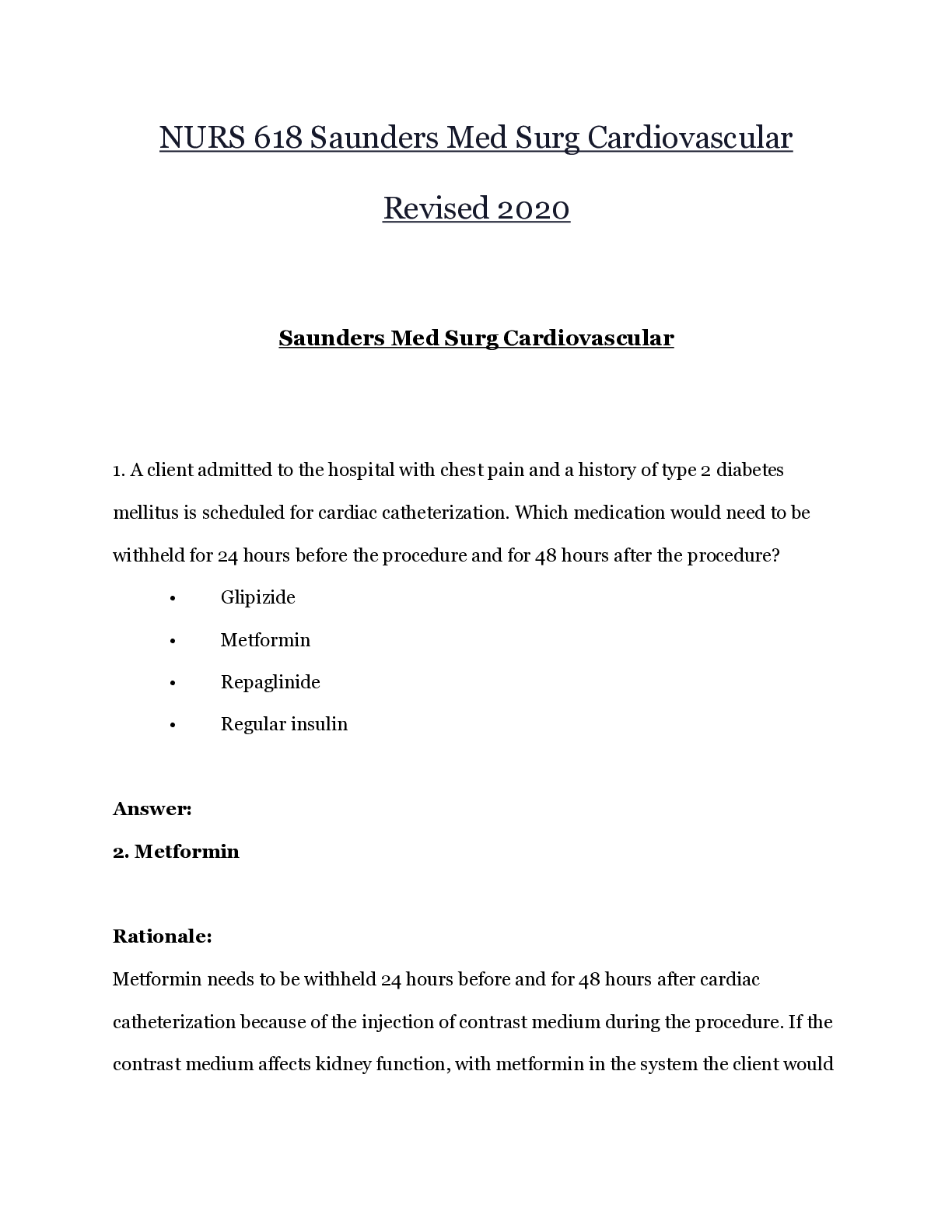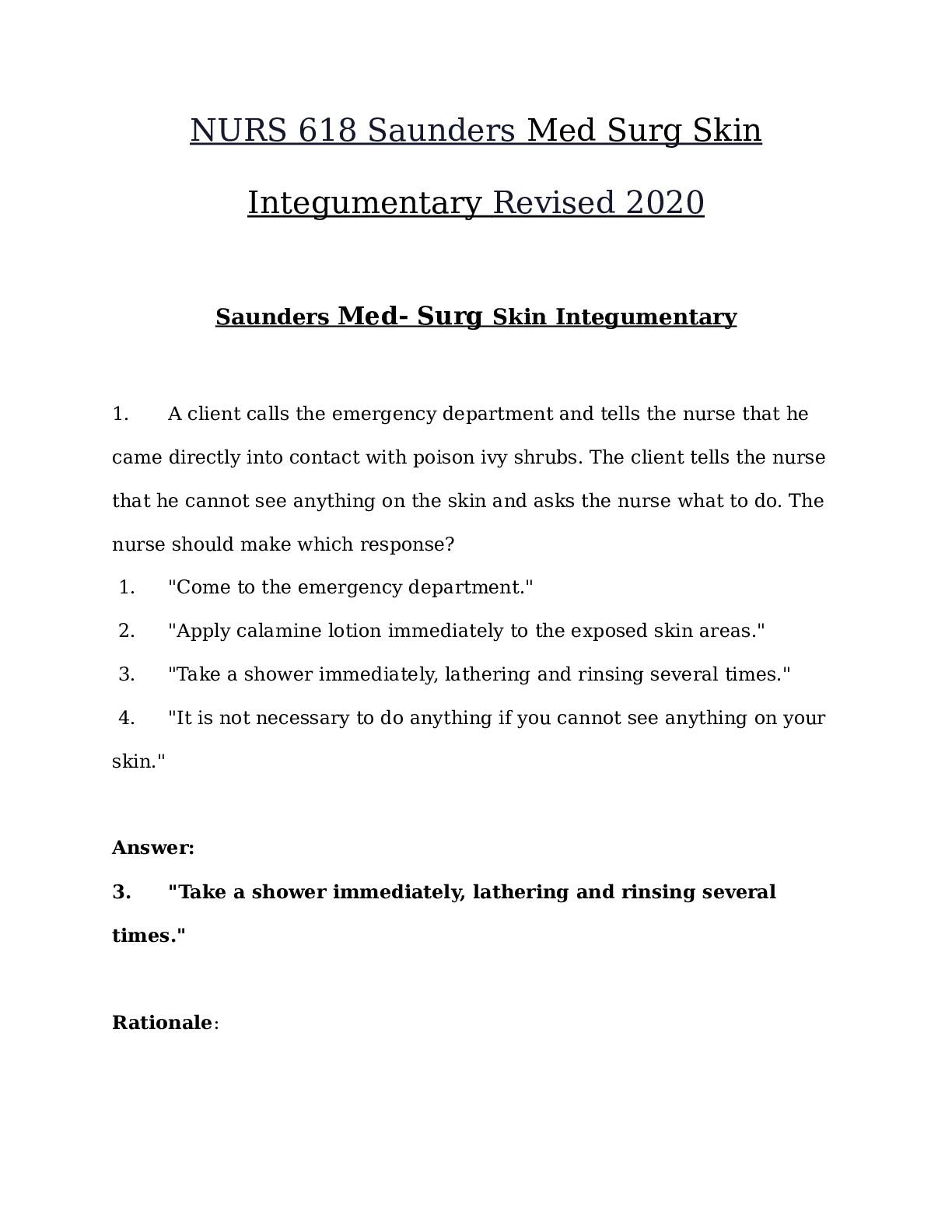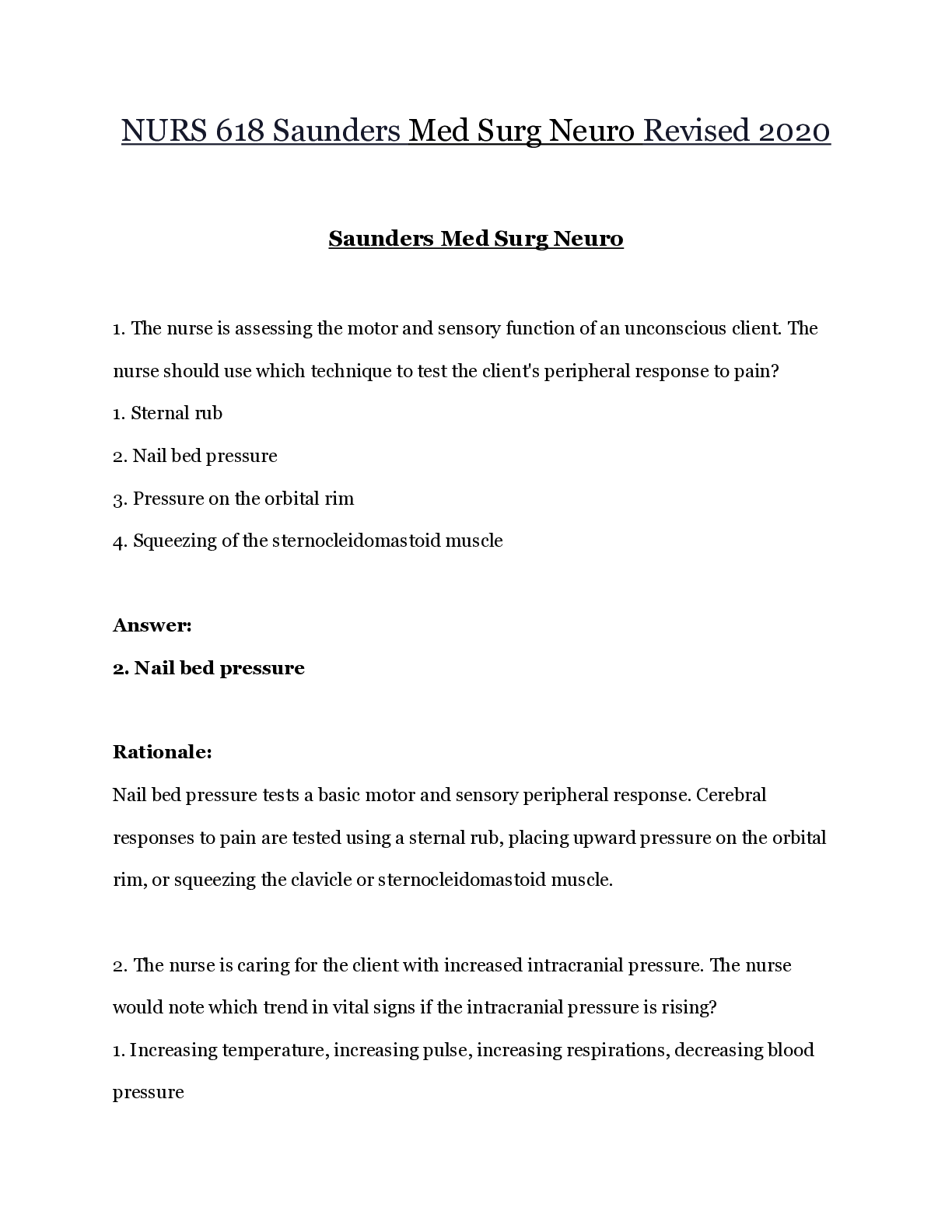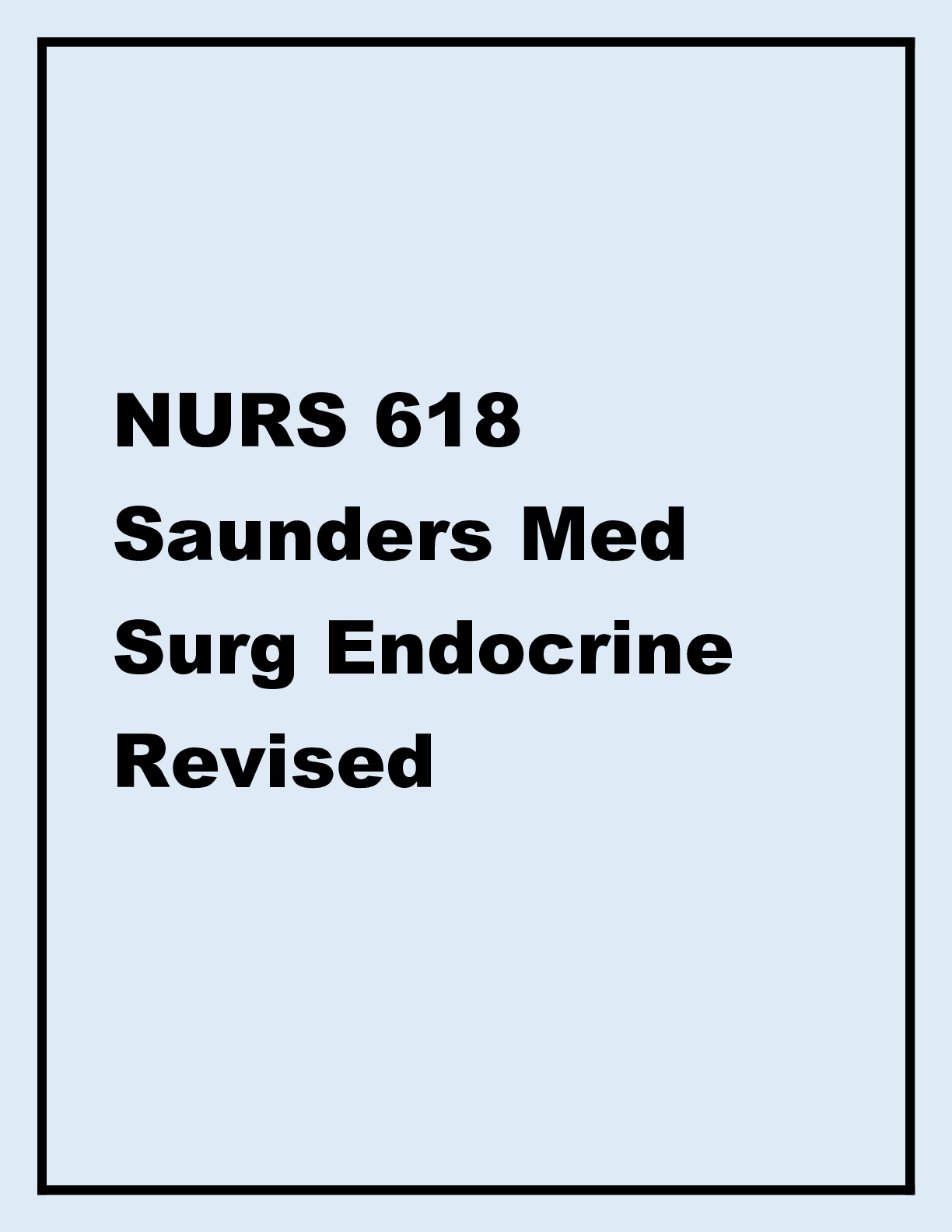*NURSING > MED-SURG EXAM > NURS 618 Saunders Med Surg Endocrine Revised (All)
NURS 618 Saunders Med Surg Endocrine Revised
Document Content and Description Below
NURS 618 Saunders Med Surg Endocrine Revised 2022 Saunders Med Surg Endocrine 1. A client is brought to the emergency department in an unresponsive state, and a diagnosis of hyperosmolar hyperg... lycemic syndrome is made. The nurse would immediately prepare to initiate which anticipated health care provider's prescription? 1. Endotracheal intubation 2. 100 units of NPH insulin 3. Intravenous infusion of normal saline 4. Intravenous infusion of sodium bicarbonate Answer: 3. Intravenous infusion of normal saline Rationale: The primary goal of treatment in hyperosmolar hyperglycemic syndrome (HHS) is to rehydrate the client to restore fluid volume and to correct electrolyte deficiency. Intravenous (IV) fluid replacement is similar to that administered in diabetic ketoacidosis (DKA) and begins with IV infusion of normal saline. Regular insulin, not NPH insulin, would be administered. The use of sodium bicarbonate to correct acidosis is avoided because it can precipitate a further drop in serum potassium levels. Intubation and mechanical ventilation are not required to treat HHS. 2. An external insulin pump is prescribed for a client with diabetes mellitus. When the client asks the nurse about the functioning of the pump, the nurse bases the response on which information about the pump? 1. It is timed to release programmed doses of either short-duration or NPH insulin into the bloodstream at specific intervals. 2. It continuously infuses small amounts of NPH insulin into the bloodstream while regularly monitoring blood glucose levels. 3. It is surgically attached to the pancreas and infuses regular insulin into the pancreas. This releases insulin into the bloodstream. 4. It administers a small continuous dose of short-duration insulin subcutaneously. The client can self-administer an additional bolus dose from the pump before each meal. Answer: 4. It administers a small continuous dose of short-duration insulin subcutaneously. The client can self-administer an additional bolus dose from the pump before each meal. Rationale: An insulin pump provides a small continuous dose of short-duration (rapid- or short-acting) insulin subcutaneously throughout the day and night. The client can self-administer an additional bolus dose from the pump before each meal as needed. Short-duration insulin 3. A client with a diagnosis of diabetic ketoacidosis (DKA) is being treated in the emergency department. Which findings support this diagnosis? Select all that apply. 1. Increase in pH 2. Comatose state 3. Deep, rapid breathing 4. Decreased urine output 5. Elevated blood glucose level Answers: 2. Comatose state 3. Deep, rapid breathing 5. Elevated blood glucose level Rationale: Because of the profound deficiency of insulin associated with DKA, glucose cannot be used for energy and the body breaks down fat as a secondary source of energy. Ketones, which are acid byproducts of fat metabolism, build up and the client experiences a metabolic ketoacidosis. High serum glucose contributes to an osmotic diuresis and the client becomes severely dehydrated. If untreated, the client will become comatose due to severe dehydration, acidosis, and electrolyte imbalance. Kussmaul's respirations, the deep rapid breathing associated with DKA, is a compensatory mechanism by the body. The body attempts to correct the acidotic state by blowing off carbon dioxide (CO2), which is an acid. In the absence of insulin, the client will experience severe hyperglycemia. Option 1 is incorrect because in acidosis the pH would be low. Option 4 is incorrect because a high serum glucose will result in an osmotic diuresis and the client will experience polyuria. 4. The nurse teaches a client with diabetes mellitus about differentiating between hypoglycemia and ketoacidosis. The client demonstrates an understanding of the teaching by stating that a form of glucose should be taken if which symptom or symptoms develop? Select all that apply. 1. Polyuria 2. Shakiness 3. Palpitations 4. Blurred vision 5. Lightheadedness 6. Fruity breath odor Answers: 2. Shakiness 3. Palpitations 5. Lightheadedness Rationale: Shakiness, palpitations, and lightheadedness are signs/symptoms of hypoglycemia and would indicate the need for food or glucose. Polyuria, blurred vision, and a fruity breath odor are manifestations of hyperglycemia. - - - - - - - - - - - - - - - - - - - -- 38. The nurse is providing instructions to a client newly diagnosed with diabetes mellitus. The nurse gives the client a list of the signs of hyperglycemia. Which specific sign of this complication should be included on the list? 1. Shakiness 2. Increased thirst 3. Profuse sweating 4. Decreased urine output Answer: 2. Increased thirst Rationale: The classic signs of hyperglycemia include polydipsia, polyuria, and polyphagia. Profuse sweating and shakiness would be noted in a hypoglycemic condition. 39. The emergency department nurse is preparing a plan for initial care of a client with a diagnosis of hyperosmolar hyperglycemic syndrome (HHS). The nurse recognizes that the hyperglycemia associated with this disorder results from which occurrence? 1. Increased use of glucose 2. Overproduction of insulin 3. Increased production of glucose 4. Increased osmotic movement of water Answer: 3. Increased production of glucose Rationale: Hyperglycemia results from decreased use and increased production of glucose. Increased use of glucose and overproduction of insulin would most likely cause hypoglycemia. Option 4 is incorrect. 41. The nurse is developing a plan of care for a client who is scheduled for a thyroidectomy. The nurse focuses on psychosocial needs, knowing that which is likely to occur in the client? 1. Infertility 2. Gynecomastia 3. Sexual dysfunction 4. Body image changes Answer: 4. Body image changes Rationale: Because of the location of the incision in the neck area, many clients are afraid of thyroid surgery for fear of having a visible large scar postoperatively. Having all or part of the thyroid gland removed will not cause the client to experience gynecomastia. Sexual dysfunction and infertility could occur if the entire thyroid is removed and the client is not placed on thyroid replacement medications. 44. The nurse is performing an assessment on a client with a diagnosis of myxedema (hypothyroidism). Which assessment finding should the nurse expect to note in this client? 1. Dry skin 2. Thin, silky hair 3. Bulging eyeballs 4. Fine muscle tremors Answer: 1. Dry skin Rationale: Myxedema is a deficiency of thyroid hormone. The client will present with a puffy, edematous face, especially around the eyes (periorbital edema), along with coarse facial features; dry skin; and dry, coarse hair and eyebrows. The remaining options are noted in the client with hyperthyroidism. 45. The nurse is performing an assessment on a client with a diagnosis of hyperthyroidism. Which assessment finding should the nurse expect to note in this client? 1. Dry skin 2. Bulging eyeballs 3. Periorbital edema 4. Coarse facial features Answer: 2. Bulging eyeballs Rationale: Hyperthyroidism is clinically manifested by goiter (increase in the size of the thyroid gland) and exophthalmos (bulging eyeballs). Other clinical manifestations include nervousness, fatigue, weight loss, muscle cramps, and heat intolerance. Additional signs found in this disorder include tachycardia; shortness of breath; excessive sweating; fine muscle tremors; thin, silky hair and thin skin; infrequent blinking; and a staring appearance. - - - - - - - - - - - - - - - - - - - - - - - 2. Obtain a capillary blood glucose level and quickly perform a focused assessment. Rationale: Diaphoresis and confusion are signs of moderate hypoglycemia. A likely cause of the client's change in condition could be related to the administration of insulin without the client's eating enough food. However, an assessment is necessary to confirm the presence of hypoglycemia. The nurse would obtain a capillary blood glucose level to confirm the hypoglycemia and quickly perform a focused assessment to determine the extent and cause of the client's condition. Once hypoglycemia is confirmed, the nurse stays with the client and asks the UAP to obtain the appropriate carbohydrate snack. A code is called if the client is not breathing or if the heart is not beating. 171. The nurse is caring for a client diagnosed with type 1 diabetes mellitus experiencing the Somogyi effect. Which blood glucose results and treatment would the nurse expect? 1. 0300 blood glucose 68 mg/dL (3.8 mmol/L) and 0700 blood glucose 200 mg/dL (11.1 mmol/L). Instruct to decrease amount of evening insulin. 2. 0300 blood glucose 68 mg/dL (3.8 mmol/L) and 0700 blood glucose 200 mg/dL (11.1 mmol/L). Instruct to increase amount of evening insulin. 3. 0300 blood glucose 190 mg/dL (10.6 mmol/L) and 0700 blood glucose 240 mg/dL (13.3 mmol/L). Instruct to decrease amount of evening insulin. 4. 0300 blood glucose 190 mg/dL (10.6 mmol/L) and 0700 blood glucose 240 mg/dL (13.3 mmol/L). Instruct to increase amount of evening insulin. Answer: 1. 0300 blood glucose 68 mg/dL (3.8 mmol/L) and 0700 blood glucose 200 mg/dL (11.1 mmol/L). Instruct to decrease amount of evening insulin. Rationale: With the Somogyi effect, hyperglycemia occurs in the morning as a result of hypoglycemia during the night from too much evening insulin. Treatment includes having a bedtime snack, decreasing the amount of evening insulin, or both. Thus, option 1 is the correct answer (hypoglycemia during the night and hyperglycemia in the morning, which is treated by decreasing the evening dose of insulin). Option 2 is incorrect because it instructs the client to increase the evening dose of insulin. Options 3 and 4 are incorrect because the nighttime blood glucose levels indicate hyperglycemia, which would indicate dawn phenomenon. 172. The nurse teaches a class on foot care for clients diagnosed with diabetes mellitus. Which instructions should the nurse include in the class? Select all that apply. 1. Wear closed-toe shoes. 2. Soak feet in hot water twice a day. 3. Massage lanolin lotion between the toes. 4. Cut toenails straight across and file the edges. 5. Pat feet dry gently, especially between the toes. Answers: 1. Wear closed-toe shoes. 4. Cut toenails straight across and file the edges. 5. Pat feet dry gently, especially between the toes. Rationale: People with diabetes mellitus are at high risk for foot ulcerations and resultant lower extremity amputations. The development of diabetic foot complications can be the result of a combination of microvascular and macrovascular diseases that place the client at risk for injury and serious infection. Options 1, 4, and 5 are correct, as measures should be taken to teach clients how to prevent foot ulcers and injury. These measures include wearing closed-toe shoes to protect the feet and toes (especially for those with peripheral neuropathy), cutting toenails straight across and filing the edges to avoid sharp toenail edges and cutting the skin of the toe, and drying the feet gently and thoroughly (including between the toes) to prevent maceration of the skin and infections. Option 2 is incorrect, as clients with diabetes should avoid hot water due to neuropathy and possible burns. Option 3 is incorrect, as lotion between the toes is not advised; it is necessary to keep the area between the toes dry to avoid maceration and infections. 174. A client is admitted with suspected diabetic ketoacidosis (DKA). Which clinical manifestations best support a diagnosis of DKA? 1. Blood glucose 500 mg/dL (27.8 mmol/L); arterial blood gases: pH 7.30, PaCo2 50, HCO3– 26. 2. Blood glucose 400 mg/dL (22.2 mmol/L); arterial blood gases: pH 7.38, PaCo2 40, HCO3– 22. 3. Blood glucose 450 mg/dL (25.0 mmol/L); arterial blood gases: pH 7.48, PaCo2 39, HCO3– 29. 4. Blood glucose 350 mg/dL (19.4 mmol/L); arterial blood gases: pH 7.28, PaCo2 30, HCO3– 14. Answer: 4. Blood glucose 350 mg/dL (19.4 mmol/L); arterial blood gases: pH 7.28, PaCo2 30, HCO3– 14. Rationale: DKA is caused by a profound deficiency of insulin and is characterized by hyperglycemia (blood glucose level greater than or equal to 250 mg/dL [13.9 mmol/L]), ketosis (ketones in urine or serum), metabolic acidosis, and dehydration. The correct option is 4, as it represents an elevated blood glucose and the arterial blood gases (ABGs) indicate metabolic acidosis. Option 1 is incorrect, as the ABGs indicate respiratory acidosis; option 2 is incorrect, as the ABG values are within normal; and option 3 is incorrect, as the ABGs indicate metabolic alkalosis. 175. The nurse is monitoring a diabetic client with a blood glucose level of 400 mg/dL (22.2 mmol/L). Which clinical manifestation would indicate diabetic ketoacidosis (DKA)? 1. Bradycardia 2. Cool, clammy skin 3. Lower extremity edema 4. Rapid, deep respirations Answer: 4. Rapid, deep respirations Rationale: DKA is caused by a profound deficiency of insulin and is characterized by hyperglycemia (blood glucose level greater than or equal to 250 mg/dL [13.9 mmol/L]), ketosis (ketones in urine or serum), metabolic acidosis, and dehydration. The correct option is 4. This is because the body's compensatory response to the metabolic acidosis is to increase carbon dioxide (CO2) excretion by the lungs through deep, rapid breathing (Kussmaul respirations). Options 1, 2, and 3 are incorrect, as clients with DKA are dehydrated and thus have an increased heart rate and dry, scaly skin and do not have lower extremity edema. ENDOCRINE QUESTIONS from Saunders Oncology Adult Health Qs 35. ENDOCRINE QUESTION: The nurse is reviewing the record of a client who was admitted to the hospital with a diagnosis of ovarian cancer. A client has received an unsealed radioactive isotope for treatment of thyroid cancer. Which instruction is essential for the nurse to provide the client? 1. "Flush the toilet at least 3 times after use." 2. "Increase intake of fruits with a core, such as apples and pears." 3. "Avoid contact with pregnant women, infants, and children for 3 months." 4. "Use disposable eating utensils, plates, and cups for the next 6 months." Answer: 1. "Flush the toilet at least 3 times after use." Rationale: Bodily fluids contain the radioactive material, so others should be shielded from possible exposure. Clients should at best have a dedicated toilet for use during the first 2 weeks and should also flush 3 times after use. Some radioactivity will be in the saliva for about the first week, so during this time fruits with cores that will become contaminated should be avoided. Disposable eating utensils should also be used during this period of time. Contact with pregnant women, infants, and children is avoided for the first week and then a distance of 3 feet (1 meter) or more should be maintained and exposure should be limited to 1 hour per day. [Show More]
Last updated: 1 month ago
Preview 1 out of 99 pages
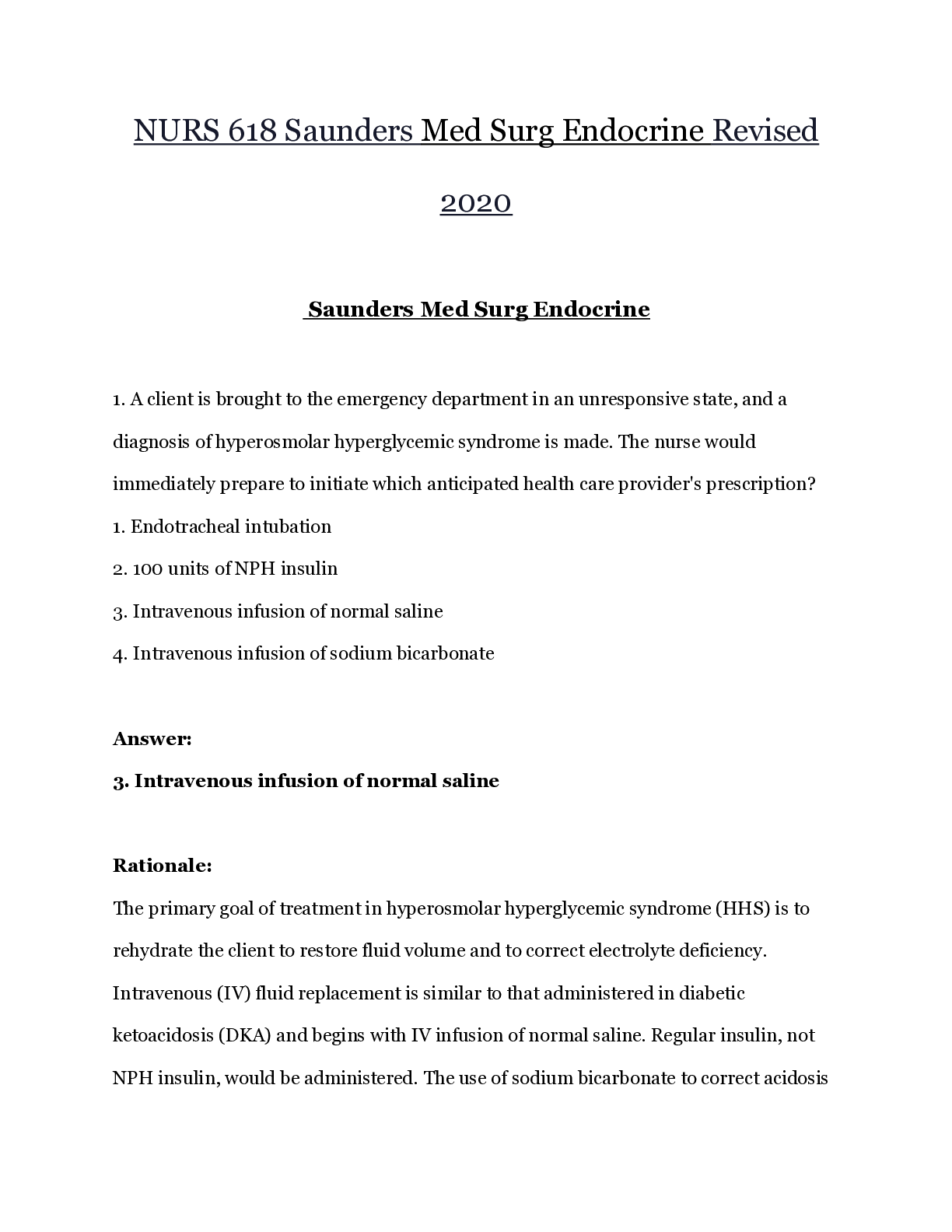
Reviews( 0 )
Document information
Connected school, study & course
About the document
Uploaded On
Nov 04, 2020
Number of pages
99
Written in
Additional information
This document has been written for:
Uploaded
Nov 04, 2020
Downloads
2
Views
114

